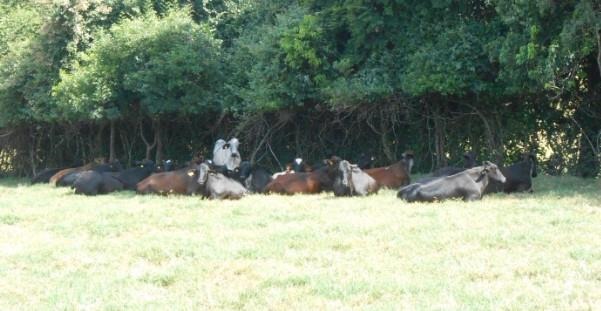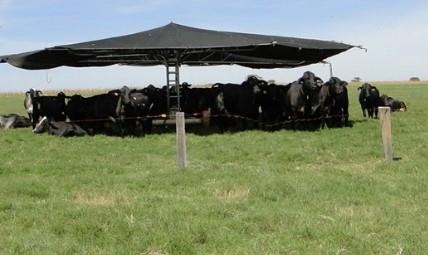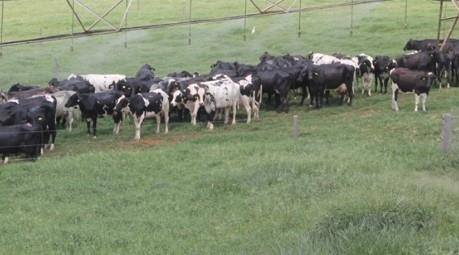By Victor Malacco
Prioritizing shade, ample water access, and thoughtful management practices are crucial for protecting grazing dairy cows from heat stress, promoting their well-being and productivity during hot summer periods.

Figure 1. Signs of heat stress in dairy cattle.
Summer is around the corner, and as temperatures gradually rise, it is essential to recognize the potential challenges heat stress poses on dairy cows. Grazing cows are even more exposed since direct solar radiation exacerbates their vulnerability to heat stress alongside the rising ambient temperatures they encounter. Heat stress can significantly impact dairy cattle, even in states with shorter warm weather seasons like Michigan or New York. Cows in temperate regions may not be physiologically adapted to withstand heat stress conditions. As a result, even sporadic instances of heat stress can prove challenging for these cows, leading to significant losses in production. Therefore, farmers need to be aware of the signs of heat stress, its causes, and how to identify and abate it.
What is heat stress in cows?
Heat stress occurs when the body cannot get rid of excess heat. A cow’s heat load is composed of the heat it produces through metabolism plus heat gained from the environment. To remain comfortable, cows must balance the heat load by releasing excess body heat. They do that through various processes, including conduction, convection, radiation, and evaporation. However, during sustained periods of high ambient temperature, especially when combined with high humidity, heat accumulation can surpass a cow’s ability to release excess body heat, which leads to heat stress.
The temperature-humidity index (THI) is widely used to assess how challenging an environment
is for animals at a specific moment. THI is calculated using a combination of environmental temperature and humidity and can be used to predict animal heat load. For dairy cows, a THI cutoff of 68 means that cows are under heat-stress conditions. These cutoffs were based on studies that observed reduced milk production in dairy cows.
Not all animals respond the same under the same THI. In addition, to weather conditions, the susceptibility and responses of dairy cows to heat stress are influenced by factors such as milk production level, stage of lactation, breed characteristics, and coat color.
A recent study that evaluated dairy cows’ time budget changes due to an increase in temperature and THI in temperate climates observed that cows began to adjust their daily time budgets when the temperature reached 54 degrees Fahrenheit, and the THI reached 56. Cows decreased their time lying, eating, and walking while increasing their standing time, indicating that heat stress can affect our high-producing cows at lower THIs than predicted before.
The impact of heat stress on cows
Heat stress significantly impacts dairy cattle and can result in direct and indirect economic losses. Direct financial losses are caused by reduced milk production due to decreased feed intake and increased energy spent to control internal temperature. Indirect economic losses are caused by decreased milk production in the subsequent lactation cycle, reduced production life, and increased culling rates. As mentioned, as temperature increases, cows tend to increase their standing time to dissipate heat, which has been speculated can increase losses due to more significant milk losses and a potential increase in herd lameness rates during summer.
Recent studies have shown that exposure to heat stress during late gestation (dry period) will affect the cow’s next lactation and even extend to the performance of their daughters and granddaughters. In Michigan, for example, the estimated economic losses due to heat stress are around $18.4 million per year.
Identifying heat stress in cows
First things first, farmers must be able to identify the early signs of heat stress in order to minimize its effects on their herd. This includes increased respiration rate (more than 60 respiration movements per minute), increased water intake, and reduced grazing time, sometimes observed as lower milk in the bulk tank. Severe panting is the most recognizable sign of heat stress, and cows with severe heat stress will pant with their tongues hanging out. This is often accompanied by drooling. Grazing cows will seek shade or hang out around the water trough.
Here is a video available in English and Spanish summarizing the impact of heat stress and the signs of heat stress in dairy cows.
Managing heat stress in cows
To minimize the negative impact of heat stress on cow comfort and productivity, several strategies can be implemented:
Providing shade: During periods of a high probability of heat stress, cows should have access to paddocks with shade, ideally providing at least 40 square feet of shade per cow to avoid competition. Shade provided by trees is an effective strategy, and assuring the proper space/cow will reduce mud formation and the chances of killing the tree. Having a tree or two in the paddock is a welcome gift to the cows, but it's essential to consider the impact on pasture health when all the cows concentrate in one spot, resulting in excessive shade and concentrated manure. This can hinder pasture availability and regrowth, especially in rotational grazing systems. Some farmers have devised a practical solution to address this issue: planting trees in rows along the lanes. The trees can serve as paddock divisions by planting them in a row, utilizing fiberglass stakes and ties instead of step-in posts. This arrangement not only protects the newly planted trees but also facilitates effective management of the paddocks. A simple yet effective approach is to run a single strand of electric fencing between the livestock and the trees to safeguard the row of trees. This creates a clear barrier, preventing the cows from causing damage to the trees while still allowing them access to the pasture. Research has revealed that certain pasture grasses can thrive under partial shade conditions. By strategically integrating rows of trees, farmers can provide shade for the cows, effectively manage the paddocks, and create an environment that promotes the growth and performance of these desired pasture grasses.
Portable shade structures can also be a good solution. It allows you to control and move where your cows congregate for shade, and you can move them around within a paddock or to another paddock as needed. If you are constructing shading structures, it is crucial to ensure that the long axis of the structure is oriented in a north-south direction. As the sun moves across the sky from east to west, the bars of light and shadow travel across the area to help keep the area beneath the structure dry. Shade cloth can be installed over off-paddock facilities, such as holding pens or feeding areas, to provide shade and protection for cows. Barns or other enclosed structures, if available, can be used to house animals during the warmest part of the day.

Photo 2. Cows in the shade of trees planted in a row to provide shade.

Photo 3. Cows under a portable shade structure.
Cooling with water: Sprinklers can improve evaporative cooling for 2 to 6 hours after wetting, but cows must be soaked to the skin. Fans can be used to increase the effectiveness of sprinklers by moving the water-laden air away. Take advantage of milking time or when supplementing cows in feed bunks to cool grazing cows. If cows are grazing under pivot irrigation, one strategy can be to use the pivot to get the cows wet.

Photo 4. Cows under a portable shade structure.
Drinking water: Lactating cows require more than 30 gallons per cow per day and drink between two to six times daily. High flow rates (at least 10 gallons per minute) to the water trough should be maintained, and a water trough should be installed to minimize the walking distance for cows (a rule of thumb has water no more than 800 feet from the animals). The farther the animals have to walk to reach water, the less evenly they will graze the pasture and the more unevenly distributed the manure will be. Providing 3.5 linear inches (9 centimeters) of accessible water trough perimeter per cow and/or more than one water source can reduce the impact of dominant cows. An ideal scenario is to provide water in each paddock. Several creative ways exist, including small portable tubs with quick-connect couplers and hoses. If using a system to pipe water long distances, ensure enough water reaches the tub fast. Water lines can be buried, or pipes can be laid on the ground along a fence line or a lane. The downside of aboveground water lines is that they may heat the water on warm sunny days if not shaded. Research shows cows under heat-stress conditions can benefit from drinking cooler water.
Management: Walking distance and speed should be minimized, and cows should spend less time in unshaded yards. More yard space per cow should be provided at milking times, and milking earlier in the morning and later in the afternoon can be beneficial. Cooling cows with water and fans in the yards or waiting areas before milking is also a good strategy.
Feeding: Cows will graze less during the warmest part of the day. If any supplement is fed to the animals, consider feeding during this period of the day (usually 3-5 hours after noon - when the sun is at its highest point in the sky) in feeding areas where they are protected from direct solar radiation.
Selecting animals bred for heat tolerance: Heat tolerance in dairy cows can be altered genetically, and this option may become an important longer-term adaptive strategy as forecast higher temperatures raise the risk for heat stress on farms. One approach is the choice of breed or crossbreeding, which allows for the combination of heat resilience and production qualities by crossing, for example, Bos Indicus (more heat resistant) breeds like Gyr with temperate dairy breeds (more productive) like Holstein and Jersey. Within temperate dairy breeds, a study has shown that Jerseys are more tolerant to heat stress showing a decrease in milk production and butterfat only in situations of severe heat stress (THI > 90), while Holsteins experience this with moderate and severe heat stress. However, in this study, Jersey cows produced 20 pounds less milk (57 pounds) than Holsteins. Another strategy is the introgression of thermotolerance genes, where specific alleles associated with heat tolerance are introduced from different breeds. For example, some cows have a naturally shorter hair coat known as "slick." This distinctive coat is the result of a mutation in the prolactin receptor gene, which is naturally found in specific breeds. The inheritance pattern of this genetic mutation is dominant, meaning that offspring with a single copy of the gene will also have a short hair coat. In an effort to enhance heat tolerance, the slick gene has been introduced to the Holstein breed. Recent studies indicate that cows with the slick gene exhibit greater heat tolerance and that this genetic trait helps reduce the negative effects of heat stress on milk production. Selection criteria within breeds is another strategy, allowing for the selection of individuals based on their heat tolerance traits. This method targets a combination of traits and offers the potential to develop breeding values for heat tolerance, but it poses challenges in selecting specific genes and managing trade-offs between heat tolerance and other desirable traits. Each strategy requires careful consideration of breeding objectives, environmental conditions, and available resources.

Photo 5. A cow originated from crossing Gyr cattle, a Bos indicus breed known for its tolerance to hot temperatures, with Holstein cows.
Source : msu.edu